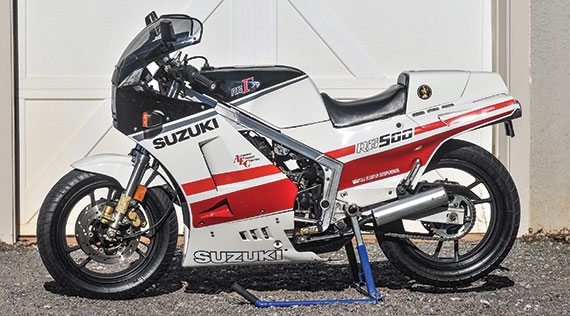
Sportbikes are one thing, street-legal repli-racers patterned on GP bikes are quite another. Both are intended for public roads, and while both are extremely fast, the repli-racer will have handling better suited to a racetrack than a mountain road.
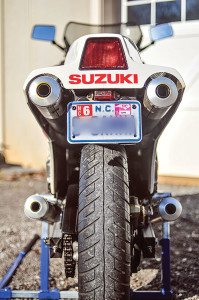
This RG500 was a repli-racer mildly popular in Europe and Canada, although never officially imported to the United States. That is not to say that the boys at U.S. Suzuki didn’t bring one in for evaluation purposes to see if it would be suitable for the American market. And eventually a few did slip over the border from our northern friends, and somehow managed to get license plates.
But the story begins 10 years earlier. Or should we say 20? Back in 1964, Suzuki bolted two 125cc two-stroke parallel-twins together to make a square four, and went racing. It had rotary valves, liquid cooling, a 6-speed transmission, lots of power—and lots of problems. It never did do much in the way of winning. Ten years later, Suzuki took the same square-four concept and upped the size to 500cc—and won world championships in 1976 and ’77.
In the early 1980s, some marketing types must have come to the questionable notion that modified GP bikes would sell well in the super-sporting market, like Honda’s NS400 two-stroke triple and Yamaha’s RZ500 V-4 (Retrospective, February 2005)—soon followed by Suzuki. Essentially, these were somewhat detuned race bikes encumbered with many, many pounds of extras to make them semi-legitimate for the street, like lights and less exhaust noise.
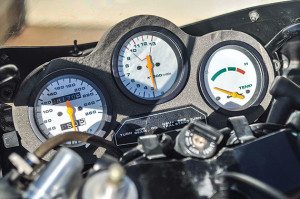
What was the RG’s motor? A square four, the two cranks geared to a pilot shaft in the middle that went out to the wet clutch—with a damper to ease the shock of many horses racing toward the transmission. This damper was not necessary on the racetrack, but essential for longevity on public roads. The pistons were arranged in pairs, each pair firing 180 degrees apart and allowing for perfect balance, so no power-sapping balance shafts were needed. The oversquare engine’s cylinders each had a bore of 56mm, stroke, 50.6mm.
The induction system was via rotary valves, requiring each pair of Mikuni 28mm flat-side carbs to be off to the side. The exhaust used a rotating valve, powered by Suzuki’s Automatic Exhaust Control, or SAEC; this involved a servomotor and cables opening and closing the valve to maximize power. Pop the tank (5.8 gallons) off and lots of the engine’s little accessories
could be seen.
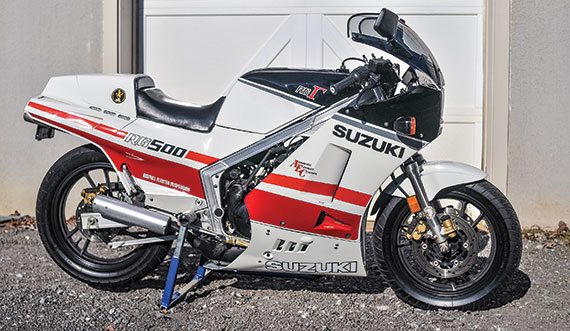
All this two-stroke “valving” resulted in the power being either on or off. The tachometer face didn’t even begin counting until 3,000 rpm, and the mid-range was pretty pathetic. But hit 6,500 rpm and that front wheel would easily point the way to heaven and keep it there all the way to the power max at 9,500. On the Canadian model, Suzuki promised 95 horses at the pilot shaft, with a dozen or more being lost on the way to the rear wheel. A genuine GP engine could easily exceed 120 horsepower. Still, with a lightweight rider in the saddle, the RG could turn a respectable 11-second quarter-mile at 120 mph, with a top speed of more than 130.
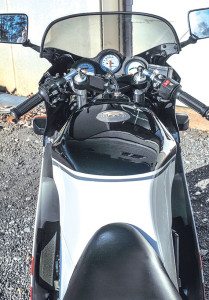
All those ponies ran through a geared primary and into a 6-speed transmission. This was the cassette type used on most racing bikes, wherein the cover is taken off and the whole set of gears comes out, a new set installed. Access was easy, as the five-piece fairing could be taken off in a couple of minutes.
The chassis was faithful to the race bike, with the frame being made of lightweight box-section aluminum alloy with a large, cast steering head that conducted the air to the carbs. The structure was stiff, built to go extremely fast, not to plonk through traffic or go through serious twisties. Several British reviews commented on how exhausting a ride this GP replica really was, and that it was best to plan a route carefully, recommending country roads, gentle curves and a lot of short straights allowing the rider to relax a little. This was a bike that required total attention, and a couple of good hours would leave the rider plumb wore out.
At the front, the 38mm fork came with alterable spring rates, air-adjustability and an anti-dive system. It had a steep rake angle of 25 degrees, with trail of 4.4 inches, good for high speeds, not so good for maneuvering through a parking lot. At the rear, an alloy square-section two-sided swingarm ran to both ends of the axle, connected to a full-floating single shock absorber. Cast wheels were a 2.50-16 at the front, 2.75-17 at the back, wearing 110/90 and 120/90 rim protectors. Squeeze the front brake lever and excellent stopping power came from eight floating pads closing in on two 10-inch discs—though it was not very useful should the front wheel be in the air. The rear single, 8-inch disc apparently did a commendable job, especially considering that wheel was usually on the apshalt, although with just two pads in the caliper. Wheelbase was a brief 56.1 inches.
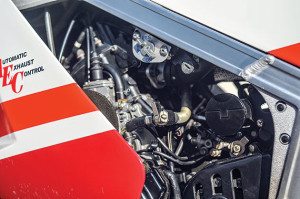
Turn signals, head- and taillights, horn, dual seat with passenger pegs—this bike had all the pretensions of being a street bike, with a wet weight of just over 400 pounds. Not so curiously, none of the contemporary reviews seemed to ever mention riding two-up.
The big question was: Who would want an RG? In 1985, Suzuki also introduced the very spiffy Superbike contender, the GSX-R750, with an in-line, four-stroke engine. Granted, it was a bigger, heavier bike, but a heck of a lot easier to ride than the RG.
Also, Uncle Sam nixed the import of the RG500, since he didn’t like two-stroke emissions.








Just wanted to take the time to thank you for these “Retrospectives” – good reading and much appreciated.
You’re welcome, Peter!
Only 75 HP at the rear wheel, but 141 MPH. (228 km/h)
She does not cheat more than the others…
Owned one from ’89 to ’02, a blast to ride and thank-you for the trip down memory lane. I still get to visit her from time to time. She is in the loving hands of a good “single” friend of mine. Lol.